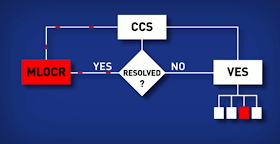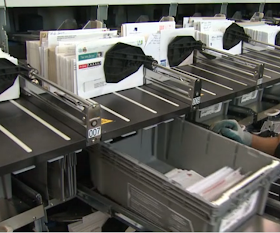In 1995, Canada Post Corporation (CPC) did a most unusual thing. It issued stamps without denominations. In this era of "P" (permanent) stamps this may not appear to be a significant action but it was quite bizarre in 1995. The first non-denominated stamp was issued on May 1, 1995 commemorating the 30th anniversary of the Canadian flag.
This was followed on May 5, 1995, by a set of 5 non-denominated stamps issued in se-tenant format featuring the Fortress and town of Louisbourg, Nova Scotia. The issue marked the 275th anniversary of the official
founding of the fortress; the 250th anniversary of the siege by the New
Englanders; the 100th anniversary of the commemoration by the Society
of Colonial Wars; and the 100th anniversary of the arrival of the
Sydney and Louisbourg (S & L) Railway.
Se-tenant set of 5 stamps
The domestic letter rate at that time was 43 cents. The rate increased to 45 cents on August 1, 1995. These were the only stamps that were issued without denominations in
1995. Subsequent issues to July 14, 1995 were printed with 43 cent
denominations.Although there has been speculation that CPC issued the undenominated stamps because regulatory authority for an anticipated rate increase had been delayed. I have not been able to find a CPC news release explaining the omission of the denominations. Since I was not particularly active in my collecting pursuits in 1995, I may have missed the CPC announcement. If you know the story please email me at philcovex@gmail.com
Usages
a) To July 31, 1995
Unlike today's undenominated "P" stamp which is
always accepted at the current domestic postage price regardless of rate increases
,the non-denominated 43 cent 1995 stamps have retained their 43 cent value.
Toronto LPP to Stephenville Crossing, July 6, 1995
43 cents domestic letter rate
Stoney Creek LPP to Toronto, June 19, 1995
b) From August 1, 1995
On August 1, 1995, the domestic letter rate increased from 43 cents to 45 cents. The cover shown below was franked with a Louisbourg non-denominated (43c) stamp,in April 1996, nine months after the rate had increased to 45 cents. The cover was not taxed.
Stoney Creek LPP to Niagara Falls, April 4, 1996
45 cents domestic letter rate
Shortpaid 2 cents but not taxe
My guess is that CPC did not wish to engage in disputes regarding the non-denominated stamps and ignored post-July 31, 1995 franking shortfalls.










































